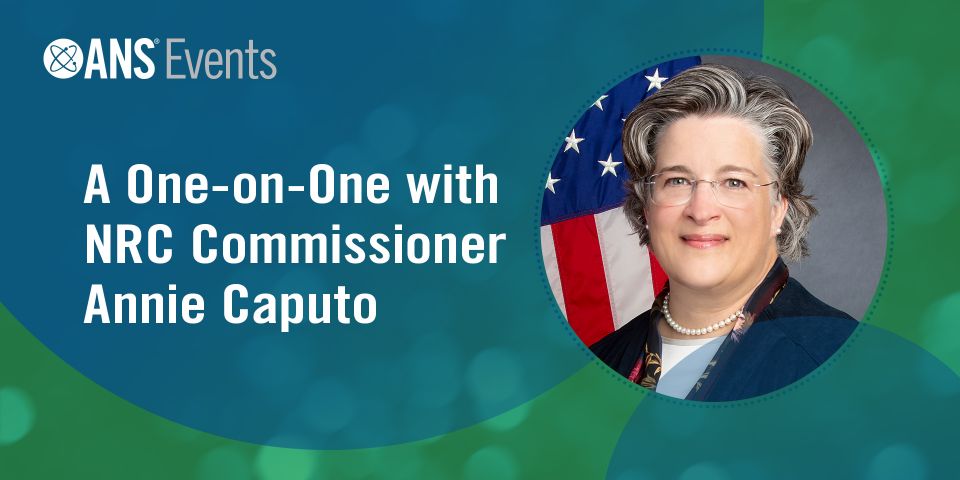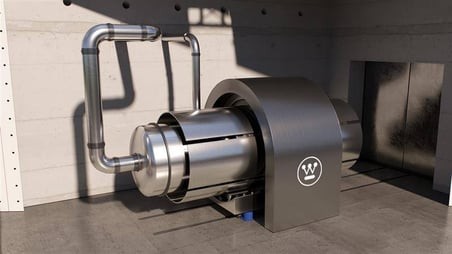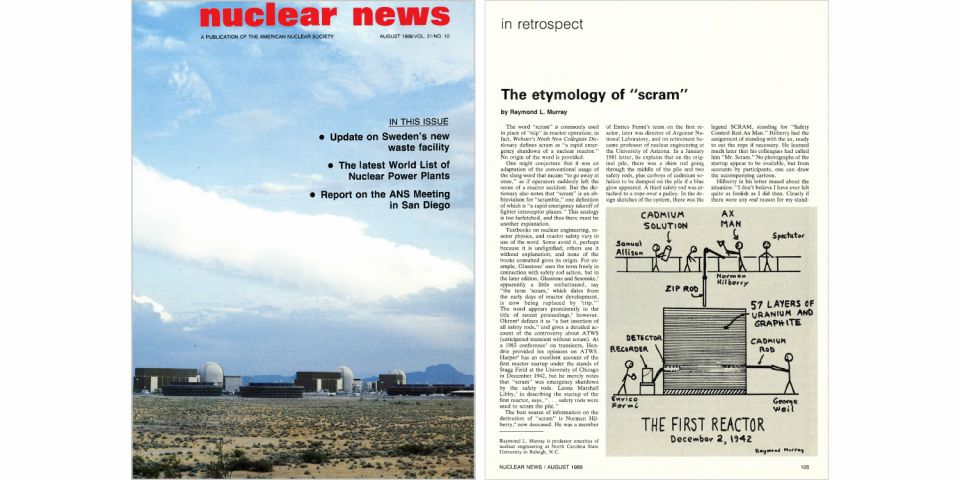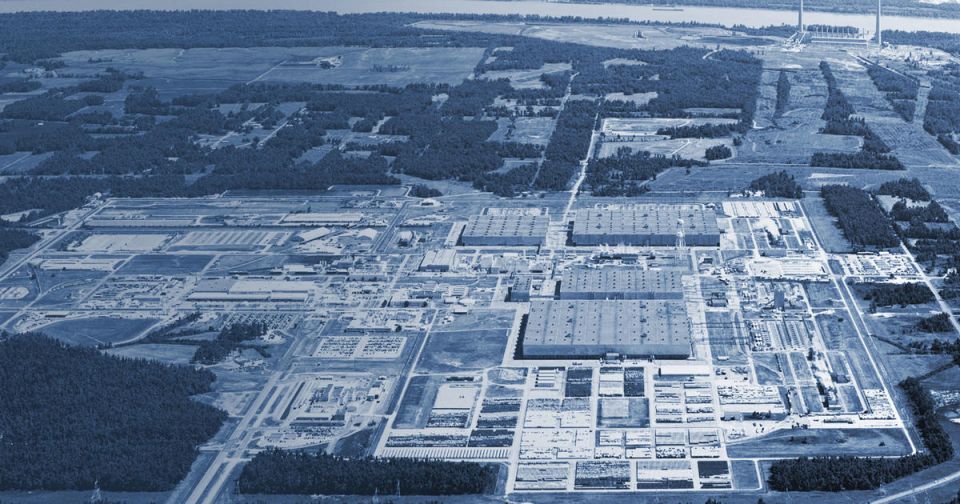Looking back at coverage of TMI

This week for the #ThrowbackThursday post, we are again turning to the April 1984 issue of Nuclear News, which was highlighted in February when we looked at the start of the federal program to convert research reactors from the use of high-enriched uranium to low-enriched uranium. This week, however, we are reviewing the coverage presented in that issue about the five-year anniversary of the Three Mile Island-2 accident.
The special section on the TMI-2 accident, which happened in March 1979, included three stories: One that provided an update of the cleanup and the state of the nuclear plant, one about the future of nuclear power from a regulator’s point of view, and a third that looked at the lessons learned from a utility manager’s perspective. All three articles offered good insight into the TMI-2 accident and the effects it had on the nuclear community. For today's #TBT post, we are sharing the second story, “Challenges for the future: A nuclear regulator's perspective.” (Perhaps next week we will we share the utility perspective and response to the regulator.)
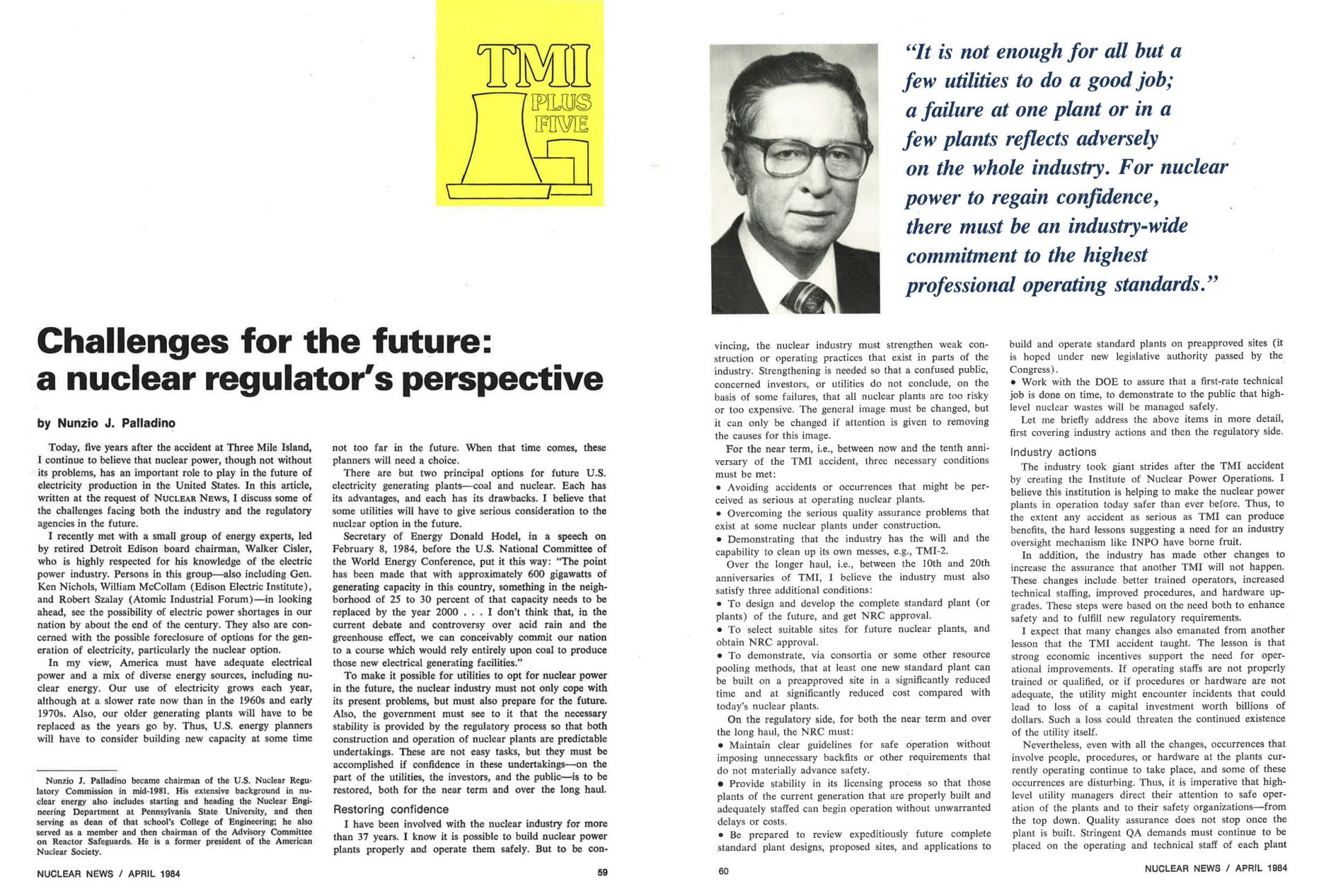 The article was written by Nunzio J. Palladino, the chairman of Nuclear Regulatory Commission at the time. He served as chair from July 1, 1981, through June 30, 1986. Palladino was in the best position to write the article, which provided an in-depth view into the choices that industry and policy leaders were faced with at the time. Palladino opened his article stating, “Today, five years after the accident at Three Mile Island, I continue to believe that nuclear power, though not without its problems, has an important role to play in the future of electricity production in the United States.”
The article was written by Nunzio J. Palladino, the chairman of Nuclear Regulatory Commission at the time. He served as chair from July 1, 1981, through June 30, 1986. Palladino was in the best position to write the article, which provided an in-depth view into the choices that industry and policy leaders were faced with at the time. Palladino opened his article stating, “Today, five years after the accident at Three Mile Island, I continue to believe that nuclear power, though not without its problems, has an important role to play in the future of electricity production in the United States.”
Palladino went on to say, “In my view, America must have adequate electrical power and a mix of diverse energy sources, including nuclear energy. Our use of electricity grows each year, although at a slower rate now than in the 1960s and early 1970s. Also, our older generating plants will have to be replaced as the years go by. Thus, U.S. energy planners will have to consider building new capacity at some time not too far in the future. When that time comes, these planners will need a choice.”
He continued, "It is not enough for all but a few utilities to do a good job; a failure at one plant or in a few plants reflects adversely on the whole industry. For nuclear power to regain confidence, there must be an industry-wide commitment to the highest professional operating standards.”
Read the rest of Palladino’s article below. Remember, the full Nuclear News archive is available to all ANS members.
Challenges for the future: a nuclear regulator's perspective
by Nunzio J. Palladino
Today, five years after the accident at Three Mile Island, I continue to believe that nuclear power, though not without its problems, has an important role to play in the future of electricity production in the United States. In this article, written at the request of Nuclear News, I discuss some of the challenges facing both the industry and the regulatory agencies in the future.
I recently met with a small group of energy experts, led by retired Detroit Edison board chairman, Walker Cisler, who is highly respected for his knowledge of the electric power industry. Persons in this group-also including Gen. Ken Nichols, William McCollam (Edison Electric Institute), and Robert Szalay (Atomic Industrial Forum)-in looking ahead, see the possibility of electric power shortages in our nation by about the end of the century. They also are concerned with the possible foreclosure of options for the generation of electricity, particularly the nuclear option. In my view, America must have adequate electrical power and a mix of diverse energy sources, including nu_ clear energy. Our use of electricity grows each year, although at a slower rate now than in the 1960s and early 1970s. Also, our older generating plants will have to be replaced as the years go by. Thus, U.S. energy planners will have to consider building new capacity at some time not too far in the future. When that time comes, these planners will need a choice.
There are but two principal options for future U.S. electricity generating plants-coal and nuclear. Each has its advantages, and each has its drawbacks. I believe that some utilities will have to give serious consideration to the nuclear option in the future.
Secretary of Energy Donald Hodel, in a speech on February 8, 1984, before the U.S. National Committee of the World Energy Conference, put it this way: “The point has been made that with approximately 600 gigawatts of generating capacity in this country, something in the neighborhood of 25 to 30 percent of that capacity needs to be replaced by the year 2000 I don't think that, in the current debate and controversy over acid rain and the greenhouse effect, we can conceivably commit our nation to a course which would rely entirely upon coal to produce those new electrical generating facilities.”
To make it possible for utilities to opt for nuclear power in the future, the nuclear industry must not only cope with its present problems, but must also prepare for the future. Also, the government must see to it that the necessary stability is provided by the regulatory process so that both construction and operation of nuclear plants are predictable undertakings. These are not easy tasks, but they must be accomplished if confidence in these undertakings-on the part of the utilities, the investors, and the public is to be restored, both for the near, term and over the long haul.
Restoring confidence
I have been involved with the nuclear industry for more than 37 years. I know it is possible to build nuclear power plants properly and operate them safely. But to be convincing, the nuclear industry must strengthen weak construction or operating practices that exist in parts of the industry. Strengthening is needed so that a confused public, concerned investors, or utilities do not conclude, on the basis of some failures, that all nuclear plants are too risky or too expensive. The general image must be changed, but it can only be changed if attention is given to removing the causes for this image.
For the near term, i,e., between now and the tenth anniversary of the TMI accident, three necessary conditions must be met:
- Avoiding accidents or occurrences that might be perceived as serious at operating nuclear plants’
- Overcoming the serious quality assurance problems that exist at some nuclear plants under construction.
- Demonstrating that the industry has the will and the capability to clean up its own messes, e.g’, TMI-2.
Over the longer haul, i.e., between the 10th and 20th anniversaries of TMI, I believe the industry must also satisfy three additional conditions:
- To design and develop the complete standard plant (or plants) of the future, and get NRC approval.
- To select suitable sites for future nuclear plants, and obtain NRC approval.
- To demonstrate, via consortia or some other resource pooling methods, that at least one new standard plant can be built on a preapproved site in a significantly reduced time and at significantly reduced cost compared with today’s nuclear plants.
On the regulatory side, for both the near term and over the long haul, the NRC must:
- Maintain clear guidelines for safe operation without imposing unnecessary backflips or other requirements that do not materially advance safety.
- Provide stability in its licensing process so that those plants of the current generation that are properly built and adequately staffed can begin operation without unwarranted delays or costs.
- Be prepared to review expeditiously future complete standard plant designs, proposed sites, and applications to build and operate standard plants on preapproved sites (it is hoped under new legislative authority passed by the Congress).
- Work with the DOE to assure that a first-rate technical job is done on time, to demonstrate to the public that high-level nuclear wastes will be managed safely.
Let me briefly address the above items in more detail; first covering industry actions and then the regulatory side.
lndustry actions
The industry took giant strides after the TMI accident by creating the Institute of Nuclear Power Operations. I believe this institution is helping to make the nuclear power plants in operation today safer than ever before. Thus, to the extent any accident as serious as TMI can produce benefits, the hard lessons suggesting a need for an industry oversight mechanism like INPO have borne fruit. In addition, the industry has made other changes to increase the assurance that another TMI will not happen. These changes include better-trained operators, increased technical staffing, improved procedures, and hardware upgrades. These steps were based on the need both to enhance safety and to fulfill new regulatory requirements.
I expect that many changes also emanated from another lesson that the TMI accident taught. The lesson is that strong economic incentives support the need for operational improvements. If operating staffs are not properly trained or qualified, or if procedures or hardware are not adequate, the utility might encounter incidents that could lead to loss of a capital investment worth billions of dollars. Such a loss could threaten the continued existence of the utility itself.
Nevertheless, even with all the changes, occurrences that involve people, procedures, or hardware at the plants currently operating continue to take place, and some of these occurrences are disturbing. Thus, it is imperative that high-level utility managers direct their attention to safe operation of the plants and to their safety organizations-from the top down. Quality assurance does not stop once the plant is built. Stringent QA demands must continue to be placed on the operating and technical staff of each plant and on the procedures and hardware in it. Providing an outstanding staff, preparing comprehensive procedures, and keeping the equipment in tip-top shape at a nuclear plant are vital tasks that must be started early and pursued relentlessly.
It is not enough for all but a few utilities to do a good job; a failure at one plant or in a few plants reflects adversely on the whole industry. For nuclear power to regain confidence, there must be an industry-wide commitment to the highest professional operating standards.
Therefore, I urge the nuclear industry to give INPO its unqualified support. Also, industry should reflect on the distinct possibility that working with INPO could make added NRC requirements unnecessary.
INPO strives for excellence, the NRC sets standards with which all are expected to comply, and industry must embrace both. But meeting NRC standards should not be permitted to divert attention from excellence or serve as a disincentive to achieving excellence. This requires that the NRC and INPO work closely to see that their respective efforts are complementary rather than conflicting.
Quality assurance
Now let me address construction quality assurance. Few things are as damaging to the industry’s public credibility as the QA failures that have occurred at a number of plants being built, contributing in some cases to the cancellation of plants well along in construction, at a cost of billions of dollars. With respect to utility and investor confidence, one need only pick up the daily paper to read about the serious financial difficulties such problems have caused for some utilities.
We have intensified efforts at the NRC to involve top-level utility management in substantial construction quality assurance improvements. So has INPO, which is doing good work in his area. But neither the NRC nor INPO can inspect quality into a plant. The industry must build quality into the plant in the first place. Although industry leaders now have a better understanding of the necessity of building a quality plant, they must not fail to emphasize the importance of doing it right the first time, both by their own organizations and by their contractors. Contracts must emphasize quality when they are written.
While considering quality assurance, I would like to discuss one aspect of the public scrutiny of nuclear power plants that has become quite significant since the TMI accident. This aspect involves allegations of problems that come in at a time close to a licensing decision and prospective startup of a new facility.
Substantive allegations of unsafe practices or wrongdoing on the part of persons employed by the utility or its suppliers or vendors must be taken seriously and must be investigated. Similarly, persons who believe that things are being done improperly have a duty to disclose their concerns as soon as possible so that a full investigation can be made and so that all interested parties, including the utility, are treated fairly. A mechanism needs to be developed for getting people to come forward with their allegations as early as possible in the process.
Independent of attempts by the NRC to develop such a mechanism, I believe the industry can develop its own. At least one utility is trying to do this, e.g., through means such as exit interviews, but more can get into the act. A complementary approach would be for industry to address problems identified by employees during construction and to provide feedback on the actions taken; such practice could lead to both a better plant and lower cost.
I would like to see the nuclear industry take a collective look at the operating plants and the plants under construction. In taking this look, industry should consider the following:
- For operations, industry-wide help to bolster the operating capabilities of nuclear plants to increase the assurance of no accidents, e.g., management assistance for plants that are having problems, the pooling of expertise in operations (including training, maintenance, and procedures), and a possible upgrade of INPO that could lead to creating and staffing an academy for operating personnel.
- For construction, industry-wide help for troubled plants and weaker utilities, e.g., the sharing of management experiences, assistance in quality assurance, a greater voice by INPO, and the pooling of expertise in construction.
- For both operation and construction, industry-encouraged plans for dealing forthrightly with problems identified by employees to avoid late allegations of improper action.
The near-term consequences of failing to come to grips with the operational and construction challenges before the industry are cost increases, further loss of confidence, and more possible cancellations.
No assessment of nuclear power five years after TMI would be complete without noting that the damaged fuel and radioactive debris still remain in the containment at Unit 2 in central Pennsylvania, sending a signal to the public that the nuclear industry does not appear dedicated to cleaning up its messes. It is a daily reminder to the people of Pennsylvania and elsewhere in the nation—and the world, for that matter—of a sad state of affairs.
There has been progress in the cleanup. But it is not clear that the industry intends to meet even the $100-million minimum level of pledges sought by the Edison Electric Institute. There has been speculation that the recent Internal Revenue Service ruling would elicit more support, but I am not yet aware of much change.
In summary, there is not a great deal of confidence that the approximately $600-million cleanup effort still remaining will be adequately funded or expeditiously completed. And if it is not funded or completed, this does not bode well for the nuclear industry.
In recent testimony to Congress, I suggested government help as was provided at West Valley. Other suggestions from industry are needed if my proposal is not supported—suggestions that industry can endorse. There is a desire on the part of the nuclear industry to provide a better climate for the future, and I am confident this can be done. But cleaning up Three Mile Island is, in my view, a prerequisite to progress. It is high time to get on with it.
I next want to focus on industry needs for the longer haul. Will the situation 10 or 20 years after TMI be better or worse than the situation now facing U.S. nuclear power?
While no one can say what fate has in store, the following is quite clear. The nuclear industry must come up with a means of solving the problems now confronting nuclear power. Otherwise, the prospects that nuclear power will play the role that it could in America’s energy future are diminished considerably.
If the nuclear industry does not begin now, five years after TMI, to lay out plans for where it is going over the next 5 to 15 years or more, only fate can determine where it will end up. The long-term consequences of failure to plan and to implement the selected plans are the possible disappearance of the U.S. nuclear option plus the loss of future electrical capacity that the United States will need. I, therefore, challenge the industry to develop its master plan, within the constraints of our competitive enterprise system, for the next generation of nuclear plants, and to devote the sizable resources that will be necessary to carry it out.
“Just what does Palladino have in mind?” some may ask. My answer is that, being a regulator, I want to be very cautious about specific proposals lest they suggest an inability on my part to judge objectively the actions of the industry in particular cases. On the other hand, much of what I have already said lends itself to obvious areas worthy of broad industry planning. For example:
- Teams that would focus on the design, development, construction, and operational concepts best suited for future U.S. nuclear plants.
- Selection of advanced sites, with application to the NRC for approval.
- Support of a complete standard design that could be proposed for approval to the NRC and be built, on a pilot basis, on a preapproved site.
To do the job required, I believe that industry must let Congress know of its desire for licensing reform in general and for standardization and early site approvals in particular.
The regulatory side
This article would be incomplete without a discussion of what the NRC needs to do. My broad goals encompass concepts familiar to all in the nuclear community-safety and stability. Rather than dwell on the many things the NRC has done relative to these concepts, however, let me move beyond the familiar to some facts and some initiatives that represent a snapshot of my current thinking.
Some persons have declared that the problem with the NRC is that it is too antagonistic toward the industry it regulates, and that we should be more cooperative with industry to help solve the problems. I want to be sure that all recognize that we have been attempting to work with the industry. Our efforts to work with INPO and the Electric Power Research Institute are good examples. But the nature of our business and the laws under which we operate require us to have as our primary function regulation to protect public health and safety.
At the same time, we stand ready to make necessary adjustments to our regulatory framework. We have made and are still pursuing efforts to control backfitting. We have proposed licensing reform legislation, and we are working on administrative reforms that do not need legislation.
We are developing safety goals that could finally answer the question, “How safe is safe enough?” And our examination of the source term could lead to changes in current emergency preparedness requirements. All these examples illustrate our commitment to change when change is called for.
What about new initiatives? Among those, I believe the NRC should consider are the following:
- Offers to have the NRC staff sit down with each utility to work out, say, a five-year plan for the implementation of needed new requirements, and, barring some unforeseen urgent safety need, a proposal to the Commission that no additional backfits be imposed during that time period.
- Suggestions to reduce dual oversight, e.g., by not imposing new requirements in areas where INPO and the industry already have acceptable standards and effective ways of ensuring that those standards are met.
- Suggestions to make it easier for the industry to propose complete new standard designs.
We should also consider other near-term or long-term suggestions that make sense and are consistent with the NRC’s statutory responsibilities.
I would like to consider for a moment the topic of nuclear waste. The ability of this nation to settle once and for all the question of whether, and if so when and where, the high-level wastes from our commercial nuclear plants will be stored is directly relevant to the confidence that Americans have or do not have in nuclear power. Congress passed the Nuclear Waste Policy Act of 1982, thereby establishing in a law the processes and schedules for settling the nuclear waste management question. Now the NRC and the DOE must stay on top of the necessary work and be ready to make sound and timely decisions on each of the steps in the path to the final repositories. We intend to give it our best, and I am sure that the DOE intends the same. Each of the affected states must also work for the common good of all states. The American people deserve no less, for it would be difficult to exaggerate the importance of these final repositories to our nation’s energy future.
Conclusion
Today, five years after TMI, I see nuclear power beset by many problems, but still holding potential for playing a significant role in America’s energy future. The extent to which nuclear power can fulfill that potential is the open question.
For the nuclear industry to carry out the tasks and accept the challenge I have laid before it to plan collectively for the 10-20-year period after TMI, and beyond, will require large expenditures-both in terms of dollars and in terms of industry commitment. But I leave the industry with another question, “Will failure to carry out the tasks and to accept the challenge be less expensive?”



